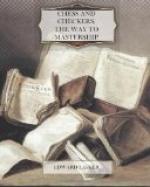However, by repeating the mating threat with (5) ..., Re6-e4, which forces White to protect, g4 by (6) P-f3 Black opens the second rank for a combined assault of the Rooks similar to the one illustrated by Diagram 30. What makes matters worse for White is that with (6) ..., R-g2+ he is forced into the line of the Bishop h3 so that he is exposed to a discovered check. After (7) K-f1, Rxb2 discovered check; (8) K-g1, Re4-e2 White must give up his Queen for the Rook immediately, as otherwise Black would mate in four moves by R-g2+, K-f1, Rxh2+, K-g1, Rb2-g2+; K-f1, Rxh1+/-.
Although White is still ahead in material after (9) Qxe2, Rxe2 he cannot avoid the loss of the game on account of the continued threat which Black exerts by the cooperation of his Rook and his Bishop. The only move which would save the Rook a1 from getting lost through R-g2+, followed by a discovered check with simultaneous attack of the Rook by Black’s Rook would be (10) R-d1 with the idea of protecting the Rook with the King thus (10) ..., R-g2+; (11) K-f1, R-d2; (12) K-e1; but this plan fails as Black checkmates with (12) ..., R-e2.
A mating position which has not been discussed up to now but which occurs frequently enough in the actual game to warrant its special mention is one in which the King is deprived of all mobility by his own men who surround him and in which a hostile Knight can check the King. Diagram 42 offers an example.
+---------------------------------------+ 8 | | | #Q | | #R | | | #K | |---------------------------------------| 7 | #P | #P | | | | | #P | #P | |---------------------------------------| 6 | | | | | | #B | | | |---------------------------------------| 5 | | | | ^R | | | ^Kt| | |---------------------------------------| 4 | | | ^Q | | | | | | |---------------------------------------| 3 | | | | | | | ^P | | |---------------------------------------| 2 | ^P | ^P | | | | | | ^P | |---------------------------------------| 1 | | | | | | | ^K | | +---------------------------------------+ a b c d e f g h
Diagram 42.
White on the move can force the mate by (1) R-d8, a very surprising sacrifice indeed, for not only can Black take the Rook with either Queen or Rook but he can also take White’s Queen. In the latter case, however, he would be mated in two moves by (2) Rxe8+, Q-g8; (3) Kt-f7. This is one example of the “throttled mate” by the Knight. Another one, which is really the typical one, occurs if Black takes the Rook instead of the Queen. The mating process then is: (2) Kt-f7+, K-g8; (3) Kt-h6 double check, K-h8; (4) Q-g8+, Rxg8; (5) Kt-f7+/-. White could not have played Q-g8+ right on the second move because then Black would have taken the Queen with the King, while he could not do so with White’s Knight on h6.




